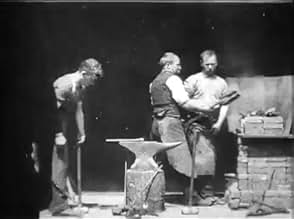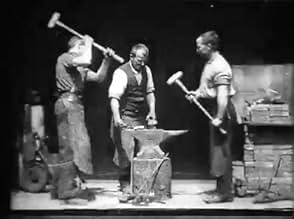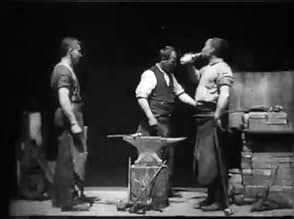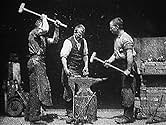IMDb-BEWERTUNG
6,2/10
2956
IHRE BEWERTUNG
Füge eine Handlung in deiner Sprache hinzuThree men hammer on an anvil and pass a bottle of beer around.Three men hammer on an anvil and pass a bottle of beer around.Three men hammer on an anvil and pass a bottle of beer around.
- Regie
- Hauptbesetzung
- Auszeichnungen
- 1 wins total
Charles Kayser
- Blacksmith
- (Nicht genannt)
Empfohlene Bewertungen
Very similar to Newark Athlete, but this time the clip runs much more smoothly. Nothing jerks, and there's only one cut. The mixing of alcohol and work also makes this slightly comical.
'Blacksmith Scene (1893)' was one of the first commercially-exhibited motion pictures, filmed in April 1893 and first screened publicly at the Brooklyn Institute on May 9, 1893. The set-up is pretty simple: three blacksmiths (actually employees of Thomas Edison) start hammering away at a heated metal rod and an anvil, before pausing to pass around a bottle of beer. The acting from two of the performers is convincing enough; the third blacksmith, on the left, doesn't even pretend that the beer bottle contains any liquid, briefly pressing the rim to his mouth and then removing it without even the pretence of drinking. The film's first seven seconds have the silhouette of a fourth party blocking the left side of the frame, before somebody presumably told him to get out of the way. While watching this didn't give me the same thrill as the Lumière brothers' 'Arrival of a Train at La Ciotat (1895),' 'Blacksmith Scene' is still an important historical curiosity. I'm grateful that the National Film Registry always remembers to honour and preserve even these apparently-innocuous snippets of cinema history.
The footage in this very early movie still looks very good, and it still works as a vignette (albeit a staged one) of life in a bygone era. In itself, it's a simple scene, but it's far from a lifeless one, and the composition works as well.
The scene, which features the leisurely-paced efforts of the blacksmiths as they do their work while occasionally refreshing themselves, is not without a little irony. Even in its day, although the blacksmith shop itself was a familiar sight, the laid-back feel of the scene was deliberately imagined as a throwback to an earlier day, rather than as a picture of the (then) present of the 1890s. (The notes in the new Kino collection of Edison films confirm this.) By contrast, many of the other earliest movies were made with a deliberate emphasis on things of the present.
The images still look quite clear in comparison with some of the other experiments in the earlier 1890s, so it must have looked quite good in its time. Then, it was an intriguing taste of things soon to come. Now, it is a chance to revisit the past.
The scene, which features the leisurely-paced efforts of the blacksmiths as they do their work while occasionally refreshing themselves, is not without a little irony. Even in its day, although the blacksmith shop itself was a familiar sight, the laid-back feel of the scene was deliberately imagined as a throwback to an earlier day, rather than as a picture of the (then) present of the 1890s. (The notes in the new Kino collection of Edison films confirm this.) By contrast, many of the other earliest movies were made with a deliberate emphasis on things of the present.
The images still look quite clear in comparison with some of the other experiments in the earlier 1890s, so it must have looked quite good in its time. Then, it was an intriguing taste of things soon to come. Now, it is a chance to revisit the past.
By the time Dickson and Edison had produced "Blacksmith Scene", the forming of the Edison company was well underway. Within three years (1890-1892) their hopes of creating motion pictures had become realized, beginning with the blurry, incomprehensible tests of the "Monkeyshines" movies to the clear, smoothly moving "Dickson Greeting" of 1891. (I cannot say much for the 1892 films as many of them appear to be lost completely, and the two remaining ones I've viewed are, shall we say, almost as bad as watching the "Monkeyshines" trilogy for whatever reason). Then came 1893, a year in which little filming in the motion picture industry seemed to take place outside of the two Edison movies "Horse Shoeing" and this film. On the other hand, the events of the year were very big: Edison's Black Maria studio was finally completed and the very first public showing of films in America was held in the Brooklyn Institute of Arts and Sciences. Among the two films to be shown at the institute was "Blacksmith Scene", and despite the fact both films were shown the exact same day and both featured a staged scenario, the other one to be shown ("Horse Shoeing") hasn't had much attribution given to it even though it was labelled as "first successful Edison film" on the three surviving stills known to exist. But I digress...
Yet, despite being only 30 seconds long, this single film (or two films, as I prefer to say) shows quite interestingly enough the potential of motion pictures. In filming these three men hammering at the anvil, the idea of filming fictitious action shows us the possibilities of special effects, of dream worlds, of everything we have today. In that sense we can say it was Edison, not Georges Méliès, who showed such possibilities. There are all sorts of clues to show you this is not a documentary film: take, for instance, the black background. Clearly a real blacksmiths shop would have a brick or cement wall instead. Furthermore, check out the brief swig the blacksmith on the left does, showing us that the bottle is probably quite empty since he would have had to tip his neck back further to drink in real life. The silhouette of the man standing in front of the camera is clearly either an assistant cameraman or a director (Dickson, in this case) directing the action, who must have been told he was blocking part of the scene, or have realized it himself as he soon steps out of the way.
As if those two things weren't enough, "Blacksmith Scene" also began a new silent era movie genre that would be copied several other times over the next couple of years. One of the earliest known remakes (but not the first) was the Lumière Brothers' "The Blacksmiths" which was also historically important as being on of the ten movies shown at the Salon Indien in the December of 1895. In the remake, it is clear some of the scenario was staged but shot in a real location with real blacksmiths, and was less important as a result. This was followed soon after by "Blacksmith in His Workshop", a Georges Méliès documentary of 1896. No comparison to that movie can be made, however, as it remains lost.
Yet, despite being only 30 seconds long, this single film (or two films, as I prefer to say) shows quite interestingly enough the potential of motion pictures. In filming these three men hammering at the anvil, the idea of filming fictitious action shows us the possibilities of special effects, of dream worlds, of everything we have today. In that sense we can say it was Edison, not Georges Méliès, who showed such possibilities. There are all sorts of clues to show you this is not a documentary film: take, for instance, the black background. Clearly a real blacksmiths shop would have a brick or cement wall instead. Furthermore, check out the brief swig the blacksmith on the left does, showing us that the bottle is probably quite empty since he would have had to tip his neck back further to drink in real life. The silhouette of the man standing in front of the camera is clearly either an assistant cameraman or a director (Dickson, in this case) directing the action, who must have been told he was blocking part of the scene, or have realized it himself as he soon steps out of the way.
As if those two things weren't enough, "Blacksmith Scene" also began a new silent era movie genre that would be copied several other times over the next couple of years. One of the earliest known remakes (but not the first) was the Lumière Brothers' "The Blacksmiths" which was also historically important as being on of the ten movies shown at the Salon Indien in the December of 1895. In the remake, it is clear some of the scenario was staged but shot in a real location with real blacksmiths, and was less important as a result. This was followed soon after by "Blacksmith in His Workshop", a Georges Méliès documentary of 1896. No comparison to that movie can be made, however, as it remains lost.
This is one of the (at least) two films that the Edison Company exhibited in their nearly completed peephole viewer, the Kinetoscope, for the first time to the public at the Brooklyn Institute of Arts and Sciences on 9 May 1893. The other, which hasn't received comparable historical attention, was "Horse Shoeing" (1893). This historical importance is why the US Library of Congress has made it the earliest film selected to its National Film Registry. The Edison Company, headed by primary filmmakers and inventors William K.L. Dickson and William Heise, had been successfully producing films as early as 1890. Additionally, they had already given a public demonstration with a proto Kinetoscope on 20 May 1891 to some 150 members of the National Federation of Women's Clubs. The film shown was "Dickson Greeting", where Dickson tips his hat--he moves.
The historical significance of primacy doesn't stop there for "Blacksmith Scene", though. Its May 1893 showing tested the Kinetoscope's commercial viability. On 14 April 1894, the first public Kinetoscope parlour opened in New York--their first commercial exhibition. Included among the 10 films that made up the original program was "Blacksmith Scene" (referred to as "Blacksmiths"). "Horse Shoeing" was there, too. Of the more interesting films also shown that day were: "Barber Shop" (1894), which was another interesting early use of the "Black Maria" as a (now) conventional studio set with a proto fictional narrative. And, "Sandow" (1894) flexing and posing in a loincloth offered an example of the voyeuristic and sexualized potential for the new medium--accentuated by the individualized peephole viewer. On 17 October of the same year, "Blacksmith Scene" (referred to as "Blacksmith Shop") was also part of the first Kinetoscope program in England.
In addition to its primacy in the commercial exhibition of motion pictures, "Blacksmith Scene" is also a historically noteworthy film in how it's staged to form an artificial setting and fictional narrative. As primitive as it appears today, it was probably the most complex film made to date. Before its filming, Dickson and Heise had filmed brief displays of sport, such as boxing, which would prove a very popular subject in early American film. Other experiments such as "Dickson Greeting" (1891) and "A Hand Shake" (1892) were mere recordings of the motion of gestures and weren't released commercially. So too were the early experiments by others like Louis Le Prince and Woodsworth Donisthorpe. Thus, the history of film as a commercial industry begins with "Blacksmith Scene".
Although with a slightly less restrictive definition of "motion pictures", one could argue that Eadweard Muybridge, Ottomar Anschütz, Émile Reynaud and others beat Thomas Edison to it. Nevertheless, this film is a departure from anything made before.
The film, "Blacksmith Scene", consists of a stationary long shot lasting around half a minute of three blacksmiths who take a brief break from blacksmithing to pass around a bottle of beer. It's primitive--a silhouette of a man standing in front of the camera and on the left-hand side of the frame is briefly seen before, I assume, being told to move out of the picture. The trademark sunlit shadows and black background of the "Black Maria" become an overused setting in the early Edison films, but in regards to the time of this film, it wasn't hackneyed yet. Nevertheless, there are three actors (in actuality, employees of Edison who worked on the invention of the Kinetoscope) pretending to be blacksmiths, and they act out a fictional scene of blacksmithing.
Moreover, as Charles Musser has pointed out, the film's narrative is nostalgic--recalling a bygone era when drinking while working was commonplace. In this sense, the film is a reconstruction of the past--something that the Edison Company would take further in "The Execution of Mary, Queen of Scots" (1895).
"Blacksmith Scene" received widespread distribution--was, in fact, one of the first such films to be seen by many, and as such, was one of the earliest films to influence other filmmakers and to encourage remakes. The Lumière Company remade it as "Les Forgerons" (Blacksmiths at Work) in 1895. Also with the title "Blacksmiths at Work" is James Williamson's film made in 1898. The Edison Company, itself, remade it in 1895 (actually their third blacksmithing scene--the first being a now-lost experiment in 1891). Although not influenced by these commercial films (or vice versa), blacksmithing was also the subject of scientific analyses around this time in films of Albert Londe, as well as Étienne-Jules Marey and Charles Fremont.
(Note: This is the second in a series of my comments on 10 "firsts" in film history. The other films covered are Traffic Crossing Leeds Bridge (1888), Annabelle Serpentine Dance (1895), The Execution of Mary, Queen of Scots (1895), La Sortie des usines Lumière (1895), L' Arroseur arose (1895), L' Arrivée d'un train à La Ciotat (1896), Panorama du Grand Canal vu d'un bateau (1896), Return of Lifeboat (1897) and Panorama of Eiffel Tower (1900).)
The historical significance of primacy doesn't stop there for "Blacksmith Scene", though. Its May 1893 showing tested the Kinetoscope's commercial viability. On 14 April 1894, the first public Kinetoscope parlour opened in New York--their first commercial exhibition. Included among the 10 films that made up the original program was "Blacksmith Scene" (referred to as "Blacksmiths"). "Horse Shoeing" was there, too. Of the more interesting films also shown that day were: "Barber Shop" (1894), which was another interesting early use of the "Black Maria" as a (now) conventional studio set with a proto fictional narrative. And, "Sandow" (1894) flexing and posing in a loincloth offered an example of the voyeuristic and sexualized potential for the new medium--accentuated by the individualized peephole viewer. On 17 October of the same year, "Blacksmith Scene" (referred to as "Blacksmith Shop") was also part of the first Kinetoscope program in England.
In addition to its primacy in the commercial exhibition of motion pictures, "Blacksmith Scene" is also a historically noteworthy film in how it's staged to form an artificial setting and fictional narrative. As primitive as it appears today, it was probably the most complex film made to date. Before its filming, Dickson and Heise had filmed brief displays of sport, such as boxing, which would prove a very popular subject in early American film. Other experiments such as "Dickson Greeting" (1891) and "A Hand Shake" (1892) were mere recordings of the motion of gestures and weren't released commercially. So too were the early experiments by others like Louis Le Prince and Woodsworth Donisthorpe. Thus, the history of film as a commercial industry begins with "Blacksmith Scene".
Although with a slightly less restrictive definition of "motion pictures", one could argue that Eadweard Muybridge, Ottomar Anschütz, Émile Reynaud and others beat Thomas Edison to it. Nevertheless, this film is a departure from anything made before.
The film, "Blacksmith Scene", consists of a stationary long shot lasting around half a minute of three blacksmiths who take a brief break from blacksmithing to pass around a bottle of beer. It's primitive--a silhouette of a man standing in front of the camera and on the left-hand side of the frame is briefly seen before, I assume, being told to move out of the picture. The trademark sunlit shadows and black background of the "Black Maria" become an overused setting in the early Edison films, but in regards to the time of this film, it wasn't hackneyed yet. Nevertheless, there are three actors (in actuality, employees of Edison who worked on the invention of the Kinetoscope) pretending to be blacksmiths, and they act out a fictional scene of blacksmithing.
Moreover, as Charles Musser has pointed out, the film's narrative is nostalgic--recalling a bygone era when drinking while working was commonplace. In this sense, the film is a reconstruction of the past--something that the Edison Company would take further in "The Execution of Mary, Queen of Scots" (1895).
"Blacksmith Scene" received widespread distribution--was, in fact, one of the first such films to be seen by many, and as such, was one of the earliest films to influence other filmmakers and to encourage remakes. The Lumière Company remade it as "Les Forgerons" (Blacksmiths at Work) in 1895. Also with the title "Blacksmiths at Work" is James Williamson's film made in 1898. The Edison Company, itself, remade it in 1895 (actually their third blacksmithing scene--the first being a now-lost experiment in 1891). Although not influenced by these commercial films (or vice versa), blacksmithing was also the subject of scientific analyses around this time in films of Albert Londe, as well as Étienne-Jules Marey and Charles Fremont.
(Note: This is the second in a series of my comments on 10 "firsts" in film history. The other films covered are Traffic Crossing Leeds Bridge (1888), Annabelle Serpentine Dance (1895), The Execution of Mary, Queen of Scots (1895), La Sortie des usines Lumière (1895), L' Arroseur arose (1895), L' Arrivée d'un train à La Ciotat (1896), Panorama du Grand Canal vu d'un bateau (1896), Return of Lifeboat (1897) and Panorama of Eiffel Tower (1900).)
Wusstest du schon
- WissenswertesThe mixing of work and alcohol was commonplace in the early 19th century, especially amongst heavy laborers. By the 1890's, however, the practice had died away. The use of the bottle of beer in this film is intended to invoke a sense of comic nostalgia of a bygone era.
- VerbindungenFeatured in Edison: The Invention of the Movies (2005)
Top-Auswahl
Melde dich zum Bewerten an und greife auf die Watchlist für personalisierte Empfehlungen zu.
Details
- Laufzeit1 Minute
- Farbe
- Sound-Mix
- Seitenverhältnis
- 1.33 : 1
Zu dieser Seite beitragen
Bearbeitung vorschlagen oder fehlenden Inhalt hinzufügen

Oberste Lücke
By what name was Blacksmith Scene (1893) officially released in India in English?
Antwort




















